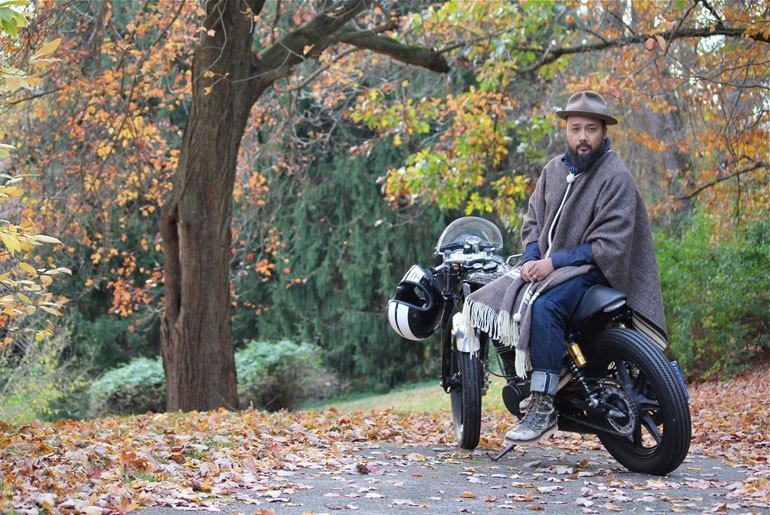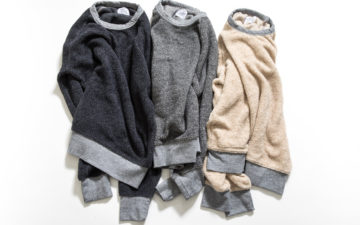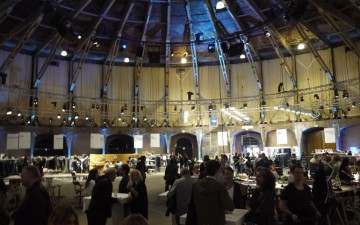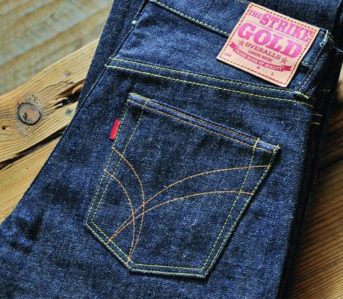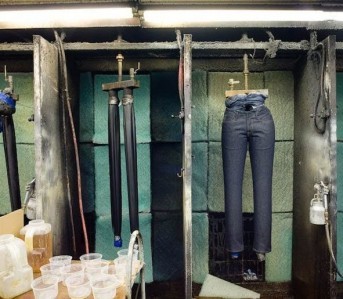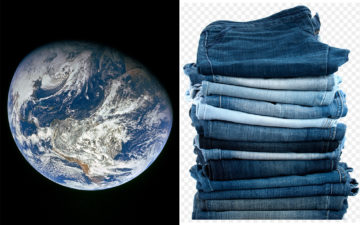Regardless of a brand’s depth, breadth, age, or focus, what we see on the surface is always just the tip of the iceberg. Ask any one (co-)founder of a successful company what helped them reach their goals and you will undoubtedly receive a long list of what’s gone right (and an equally long list of what’s gone wrong).
One factor that you’re sure to hear mention of though is the great impact of specific personnel; from the likes of specialists such as Brian Awitan. A seasoned veteran with 20 years of experience in the menswear game under his belt, Awitan has served a range of senior sales, marketing, and branding positions for some of the most well-known names around, including: Levi’s XX, Diesel, Tommy Bahama, J. Lindberg, Imogene + Willie, and Original Penguin.
He’s currently at the helm of his one man brand consulting agency, Thick as Thieves, which works with Tellason Denim, Oak Street Bootmakers, Bell Helmets, PF Flyers, House Industries, Deus ex Machina, and Horween Leather.
We were fortunate enough to steal some of his time and get his thoughts on the denim industry, shared commonalities between thriving brands, the plight of denim startups, and more.
Heddels: What’s the significance of raw denim to you?
Brian Awitan: I suppose it’s the purity. I mean, the ubiquitous “as a canvas”-significance goes without saying but ones choice of armor speaks volumes. Besides, what that earned patina reveals about the wearer is almost always more interesting than well, ya know…! But for me specifically, as an avid consumer of food & clothing, its significance lies in my ability to participate. By virtue of a raw denim garments’ state, the happenstance wear-n-tear that does personalize it is the participation. I have no formal design training. The ability to effect & customize aesthetics, by default, adds a dimension to a raw denim garment like no other.
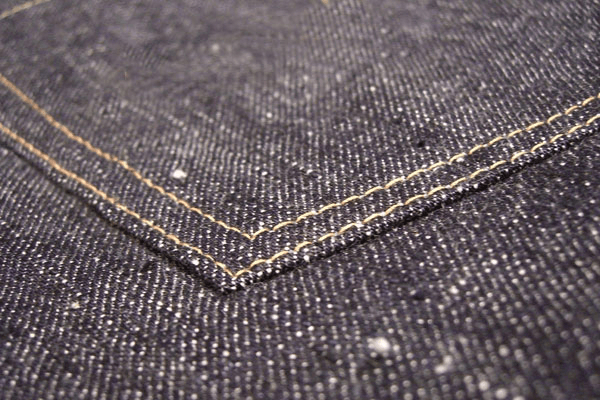
RD: What is it about the wholesale side of the denim and menswear industry that excites you?
BA: Enthusiasms. That genuine engagement that still exists in a select few. I don’t mean the fanatics, or the johnny-come-latelys. By fanatics, I mean the ones that pontificate incessantly about their knowledge but we both know that todays’ denim-fanaticism was formerly replaced by their comic book collection of yesterday and will be replaced by their gun or watch collection of tomorrow. By johnny-come-latelys, I mean the culture-vultures who see denim as a trend platform with which to simply extol their might via some gimmicky principle or focus-grouped marketing manifesto.
I’m only referring to the few who are out there that are sincerely interested and have something to add. Of course, these days, it’s mostly “what to take-away” – HA! I’ve been fortunate enough to have run across a few folks that have a reverence for origins while still looking forward. That, in and of itself, is a virtuous gene strain. These are the chosen ones, in my eyes, that will keep the culture moving.
RD: If you could work in any other position in the denim space, what would it be and why?
BA: As I’d mentioned, I have no formal training so design is definitely a (not so) secret fixation. My whole career has been predominantly in the sales, merchandising or marketing space. I’m definitely not suggesting I would make a good designer, but selfishly it would allow me to crystallize the solutions in my head that are often so hard to articulate. I have an incredible amount of respect for designers, in any field.
I mean can you imagine sweating out an idea on paper, producing that idea and presenting to the world for them to critique? I’m not totally convinced I’d have the stomach for that.
You see, on the sales or brand-facing side, it can be argued that that is a result of ‘popular trend’ or speaking to a constituency open-minded to already accepted concepts. Most good sales/brand folks are good when they’re a mirror to today’s currency, that’s what keeps anyone/thing relevant.
They are the messenger, armed with the nuances of society’s pressure points to appeal to hopes/fears/dreams for the crossover. A designer on the other hand, is “expected” to devise something completely ORIGINAL – time and time and again to incite & inspire. THAT sounds like an early heart-attack. At 44 yrs old, I’m gonna stay in my lane.
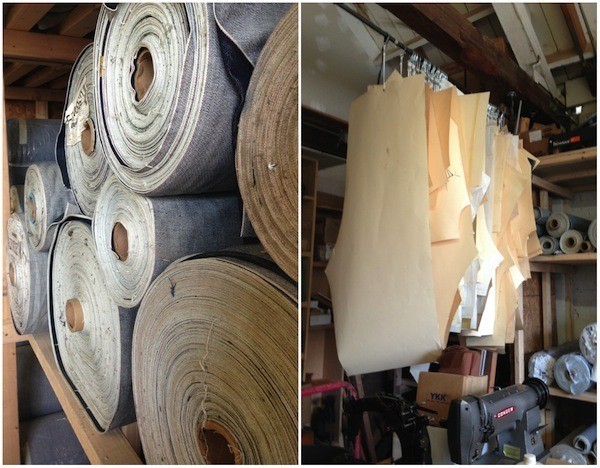
RD: You’ve spent significant time in various marketing-related roles over the course of your career and with the full gamut of companies. Whether it’s been a newer or bellwether label, what have you found are the ingredients to successful and great “branding”? How about specifically for denim brands?
BA: Consistency & repetition. It’s often over-stated, but the fundamental merits of consistency & repetition are almost always overlooked. These virtues are often replaced with “the pander”, that is, the straying from the vision or original intent. Only through consistency & repetition can any brand have a meaningful shelf-life. That, AND a brand’s ability to change behavior. I mean think about it, the brands that endure have reshaped actions, operations & associations.
Apple comes to mind. Specific to denim brands? If there are design solutions that have been satisfied based on todays’ wearer, that is never a bad thing. The trick is to improve for the spirit of improvement and not simply for the sake of change. Lest we forget the advent of the belt as the murderer of the cinch back.
RD: Over the past couple years, numerous upstart denim brands have been born in a matter of weeks through the crowd-funding platform, Kickstarter. While not all Kickstarter projects adopt this approach, one particular theme is the idea of “cutting out the middleman” with the aim of offering a lower retail price. What’s your viewpoint on this concept?
BA: It was a matter of time that this Avon-like approach would be introduced, and why not? Look, I can’t hate because that’s innovation. I applaud the application of principles from one industry to the next. Whether completely pioneering or a time-tested practice brought to the 21st century, I think it’s all meaningful. Ultimately the product will have to be compelling, at whatever price. If the consumer gets to participate in a product category tailor made for their needs and are introduced to something more than some of the sludge that exists? That’s moving things forward.
Those options are critical for end-users these days. They should have as many avenues as possible to develop their own palate, their own aesthetic and their own preference. People vote with their dollars and those dollars don’t lie. Concept is important, but if a product doesn’t do what it’s designed to do, well – you’ve just added another Shake Weight to your workout room. Congrats.

RD: One challenge that faces some artisan, handcrafted (raw) denim brands is scaling their operations. While on one hand they may wish to expand their production and wholesale potential, on the other they don’t want to risk compromising their quality and (potentially) branding. How would you recommend they grow and achieve a happy-medium balance?
BA: Ooffaa…that’s the billion dollar question, isn’t it? It takes an unbelievable amount of *__insert trappings here__* (luck/karma/determination/financing/talent/ability) to make any one thing “go”. Whether big or small, in $ volume or editorial, the “machine” that exists for brands to operate is an incredibly fragile thing. The perfect conditions of moons & stars that have to align is a f’kn unicorn(!).
I’m also not convinced a “happy-medium” exists, actually. I mean, it’s art or commerce, right? True-true artisans are just that and the financial piece at whatever level achieved, they’ll always just be doing what they do because you couldn’t stop them anyway. If the end-game is commerce measured by financial success, then you have to have an acute business acumen (or surround yourself with them) to create a platform built for speed.
Does something in between exist? Sure, but I guarantee if you ask “the middle”, they all started out at one end of the spectrum and are fighting daily to stay on either polarized side. I’ve never run into anyone that has ever told me they were mediocre or ‘somewhere in the middle’ and completely happy. My single recommendation for anyone is: remember why you started. Losing that, puts you off the rails.
RD: Overall, how do you feel the landscape of denim (both raw and non-raw) has changed over the last 15-20 years? Where do you personally see it heading in the next 3-5?
BA: There is a vibration that exists whereby people are demanding quality, in everything – product, communication, experience. The super-consumer is only getting stronger with the convergence of media and the devices available to enhance awareness. The end-user has a keen observation & possesses next-level insight. Despite the technological advances in communication, the rudimentary skills on my side of the table still have to be sharp. The competency of simply listening and having a genuine exchange of ideas socially is something that has suffered.
I have peers I came up with that gripe about “the new crop” of entitled millennials that are know-it-alls and void of any appreciation to provenance – I’m guilty of it myself! But I say it’s up to us (ahem) “veterans” to educate and impart whatever wisdom amassed in our experiences and share that. That way, the aforementioned new crop can apply whatever lessons we may have to offer to present-day propositions practiced today.
It just seems that the camaraderie I enjoyed when I was coming up has taken a backseat to self-promotion. I see it swinging back again, though, slowly. Maybe it’s the optimist in me, but I see it coming back like a community again. As it relates to product, I think the regional shifts worldwide have gotten more in sync. One no longer has to wait for things to ‘cycle-thru’ as everything is so transparent & immediate now. That whole global-citizenship notion has long arrived and the world continues to shrink. The benefit I see has been that historical aspect, of anything really, not ‘just’ denim. The sharing of knowledge and facts, no matter how wrong or incorrect they often are, just engages and encourages people to dig more. To learn more & seek out – if not for anything else, THAT is forward progression.
RD: Which denim label(s) capture your attention the most these days and why?
BA: Levi’s, for its philosophical endurance. Tough to argue 141 years of anything. Tellason, for its pure utility. they make nothing out of vanity or ego. Kapital, for its unrivaled DNA and everlasting inspiration. Rogue Territory, for its perseverance. They are so uniquely steadfast in all they achieve. Jack Knife, for its enthusiasm. Their whole-hearted commitment to the craft is moving.
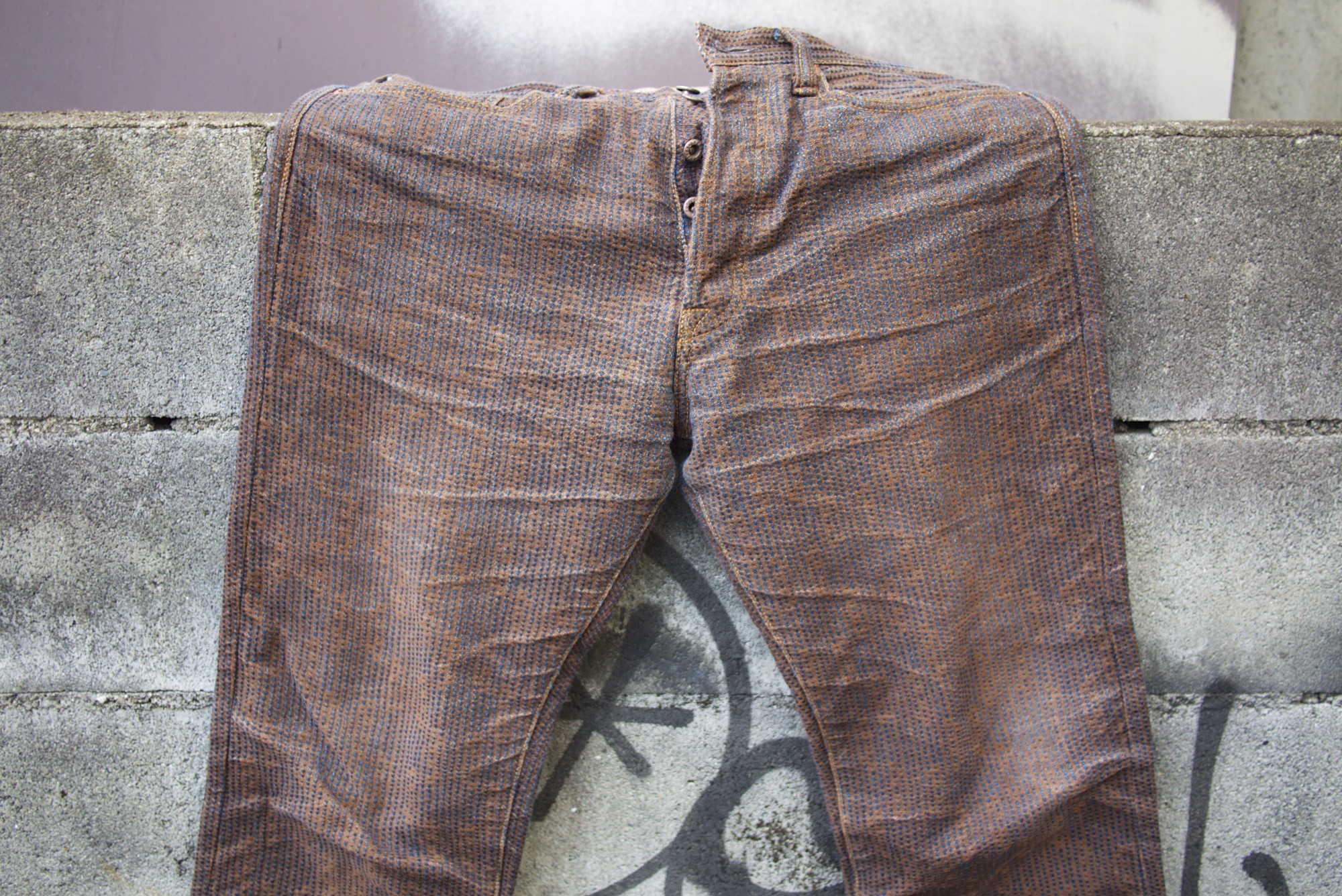
Kapital’s Century Denim
RD: What single piece of advice could you lend to early-stage denim companies/designers?
BA: Perfect a single fit. Whatever measure of success you apply to it (money, power, fame) allow that to gain, absorb and perpetuate a bit…THEN move on to another fit. Do the same, allow it to compound on itself. The next thing you know, as you look back, you might have an actual “brand” on your hands rather than a ‘label’ of pants in denim fabrication in the silhouette of 5 pockets. There is a big difference.
RD: What’s on the horizon for yourself over the remainder of 2014 and the coming years? Any chance we’ll see a Thick as Thieves capsule collection?
BA: HA. The narcissist in me undoubtedly wants an entire range by my own hand. That said, instead of dishonoring the design community with self-indulgent “duh-signs”, I have recently begun a very, very small fire-starter campaign of collaborative editions. Essentially products with existing companies naive enough to allow me to conspire an item or two. The “moniker” used is still undetermined, but will most definitely have some ‘Awitan’ attachment to it of some form.
Photo credit: Leah Awitan Photography
